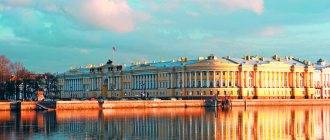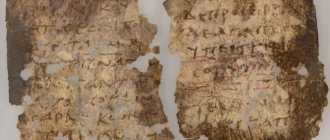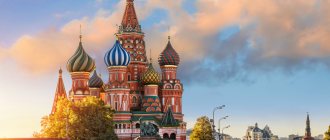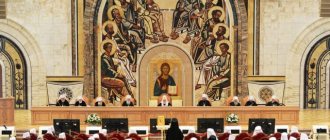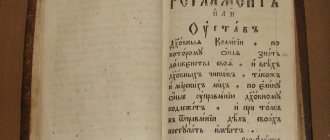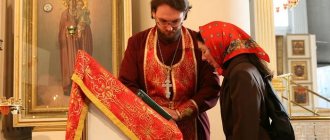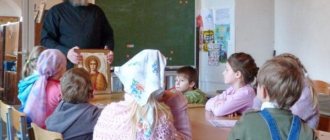History of the Russian Orthodox Church: Synodal and modern periods
| Archpriest Vladislav Tsypin. History of the Russian Orthodox Church: Synodal and modern periods / 2nd ed., revised. - M.: Publishing house. Sretensky Monastery, 2006. - 816 p. ISBN 5-7533-0406-0 |
This book is the first systematic description of a huge period in the history of the Russian Orthodox Church, from the beginning of the 18th to the beginning of the 21st centuries, written by a single author.
Doctor of Church History, professor, famous canonist Archpriest Vladislav Tsypin gives an impressive picture of the all-conquering power of God, when, under the most difficult circumstances and in the most difficult conditions, the Church managed to overcome all adversity and continue its mission to save man. TABLE OF CONTENTS
Introduction. Periodization of the history of the Russian Church of the Synodal and modern periods
PART ONE. SYNODAL PERIOD
Chapter I. The Russian Orthodox Church in the era of Peter I
- Period of locum tenens
- Establishment of the Holy Synod
- Missionary
- Spiritual enlightenment
- Monasteries and monasticism
- Religious and moral state of the people and church life
- Church art
Chapter P. Russian Orthodox Church in the 18th century.
- The relationship between the Church and the state and the highest church authority in 1725-1741.
- The relationship between the Church and the state and the highest church authority in 1741-1762.
- The relationship between the Church and the state and the highest church authority in 1762-1801.
- Diocesan administration
- Parish administration and parish clergy
- Russian Orthodox Church in the Polish-Lithuanian Commonwealth
- Missionary
- Spiritual enlightenment
- Monasteries and monasticism
- Devotees of monastic piety
- Religious and moral state of the people and church life
- Church art
Chapter III. Russian Orthodox Church in the 19th century.
- The relationship between the Church and the state and the highest church authority in 1801-1825.
- The relationship between the Church and the state and the highest church authority in 1825-1855.
- The relationship between the Church and the state and the highest church authority in 1855-1881.
- The relationship between the Church and the state and the highest church authority in 1881-1894.
- Diocesan administration
- Parish administration and parish clergy
- Orthodoxy in the Caucasus and Western Russia
- Missionary
- Spiritual education
- History of theological academies
- Translation of the Bible into Russian and St. Philaret
- Saints Ignatius (Brianchaninov) and Feofan (Govorov), recluse of Vyshensky
- Theological science
- Church historical science
- Monasteries and monasticism
- Devotees of monastic piety
- Sarov Hermitage and St. Seraphim
- Optina Pustyn
- The religious and moral state of society and religious and philosophical thought
- Church life
- Church art
- The Russian Church and the Orthodox East
Chapter IV. Russian Orthodox Church during the reign of Holy Emperor Nicholas II
- The relationship between the Church and the state and the highest church authority in 1894-1917.
- Missionary
- Theological school and church science
- The religious and moral state of society and church life
- Church art
PART TWO. RECENT PERIOD
Chapter I. Local Council of the Russian Orthodox Church 1917-1918. and restoration of the patriarchate
- Russian Church under the Provisional Government
- Composition and beginning of the activities of the Local Council
- Restoration of the patriarchate
- Biography of Saint Tikhon
- Conciliar acts after the restoration of the patriarchate
Chapter P. The Russian Orthodox Church in the Soviet era
- The relationship between the Church and the state and the highest church authority in 1917-1925.
- The relationship between the Church and the state and the highest church authority in 1925.
- The relationship between the Church and the state and the highest church authority in 1926-1936.
- The relationship between the Church and the state and the highest church authority in 1936-1943.
- The relationship between the Church and the state and the highest church authority in 1943-1944.
- Local Council 1945
- The relationship between the Church and the state and the highest church authority in 1945-1970.
- Local Council 1971
- The relationship between the Church and the state and the highest church authority in 1971-1987.
- Millennium of the Baptism of Rus' and the end of the Soviet era (1988-1990)
- Diocesan administration
- Parish administration and parish clergy
- Theological schools
- Church science and church press
- Monasteries and monasticism
- Religious and moral state of the people and church life
Chapter III. Russian Orthodox Church under His Holiness Patriarch Alexy II
- Local Council of 1990 and enthronement of His Holiness Patriarch Alexy II
- Biography of His Holiness Patriarch Alexy II
- The relationship between the Church and the state and the highest church authority in 1990-2000.
- Anniversary Council of Bishops of the Russian Orthodox Church 2000
- Diocesan administration
- Parish administration and parish clergy
- Spiritual enlightenment
- Monasteries and monasticism
- Church life
Chapter IV. Russian Church Abroad
- Church life in the canonical territory of the Moscow Patriarchate outside the Soviet Union (1918-1940)
- Church diaspora
- Spiritual enlightenment
APPLICATIONS
- Population of Russia and the USSR, including Orthodox Christians
- Number of churches and chapels
- Number of clergy
- Theological schools
- Monasteries and monasticism
- His Holiness Patriarchs of Moscow and All Rus'
- Locum Tenens of the Patriarchal Throne
- Deputy Patriarchal Locum Tenens
- Bishops of the most important dioceses
- Chief Prosecutors of the Holy Synod
- Chronological table
Sources and literature
§ 17. Optina Pustyn
The disciples of the “Moldavian elder” Paisius (Velichkovsky), dispersed to the monasteries of Russia, sought to establish eldership everywhere. It is especially firmly rooted in the Vvedenskaya Optina Hermitage.
The desert is located near the city of Kozelsk on the banks of the Zhizdra, on the forest edge. A ferry was built to access the monastery from the city. The monastery is surrounded by a wall with towers at the corners. There are several churches inside the walls, the largest of which is consecrated in honor of the Entry of the Virgin Mary. Next to the monastery, but already in the forest, is the Baptist monastery, where monks who sought solitude took refuge. The famous Optina elders also labored there.
The monastery lived according to the communal rules. Worship services lasted up to 8 hours a day. But it was not necessary for monks to come to all services - everyone could freely be guided in this by their monastic conscience, however, the spirit of the Rule penetrated so deeply into the consciousness of the inhabitants and even pilgrims that the monastery churches were always crowded with worshipers. The singing in Optina was usually a pillar one - it preserved the ancient singing in “podobny”, which in the 19th century was almost forgotten everywhere. To commemorate the dead, the monastery had 4 large synodics, the oldest of which dates back to 1670 and contained more than 50 thousand names. If the synodikon did not have time to read during the Liturgy, then they made a bookmark and completed the reading at the next Liturgy.
The monastery almost never hired workers. All the main work, field, forest, in the kitchen and in the workshops, was carried out by the monks and novices themselves. This system of monastic life developed already in the 19th century, and the beginning of Optina goes back to ancient times - to the 15th century. According to legend, its founder was the hermit Opta. But in the 18th century it was a small monastery that fell into disrepair. During Catherine’s era of the great devastation of the monasteries in Optina, there were only three inhabitants left. Metropolitan of Moscow and Kaluga Platon (Levshin), stopping here while passing through, was struck by the beauty of the place and ordered the deserts to be put in order.
Hieromonk Abraham, appointed rector of Optina, began improving the monastery. Together with him, several monks from the Pesnoshsky monastery near Moscow crossed into the desert. Over time, they were joined by monks from other monasteries. Together they revived Optina. A bell tower was erected in the monastery and construction began on a temple in honor of the Kazan Icon of the Mother of God. From now on, Metropolitan Platon called Optina “the second Lavra of his diocese.”
At the beginning of 1825, monk Moses (in the world Timofey Putilov) was appointed rector of Optina. He was born in 1782 in Borisoglebsk, Yaroslavl diocese. I felt the monastic calling already in my youth. In Moscow, where Timofey and his brother Jonah were sent to study commercial business, they met with the reclusive mother Dosithea, and she introduced them to the Novospassky elders Alexander and Philaret, who were in correspondence with Schema-Archimandrite Paisius (Velichkovsky).
In 1804, both brothers, leaving their affairs, went to Sarov and were accepted there as novices. Jonah, tonsured with Isaiah, subsequently became the rector of Sarov, and Timothy, leaving Sarov, settled as a hermit in the dense forests of Roslavl in the community of several elders who came from Moldavia from the Monk Paisius. Here he took monastic vows, and his younger brother Alexander, tonsured with the name Anthony, also came to him.
One day, Father Moses, passing from Moscow, visited Optina, where he was introduced to Archbishop Philaret of Kaluga, who instructed him to set up a monastery at Optina. In 1821, Father Moses and his brother Anthony moved to Optina and began building a monastery. The newly arrived hermits cleared the place of the forest growing here, from uprooted trees they built a church, consecrated in the name of the Prophet and Forerunner John, and cells, which began to be filled with monks.
In 1825, Father Moses was put in charge of Optina Hermitage. His continuous work as abbot continued for 37 years. During his abbotship, the number of brethren increased many times, and by the beginning of 1860 it was close to 150. Orchards were planted in the monastery, a refectory, a hotel, seven cell buildings, a mill were built, two new churches were erected, and a library was built.
And all construction began without funds.
• Do you have; Father, money? - Father Archimandrite was sometimes asked at the start of construction.
“Yes, yes,” he said, and showed 15, 20 rubles.
• But it’s nothing.
• I forgot about God, I don’t have it, but He has it.
And his faith was never disgraced.
The poverty of Father Moses knew no bounds. To help those in need, he sometimes bought rotten supplies from them at a high price and ate them himself, kept orphans on his payroll, and assigned them to scare away crows or catch moles. The pilgrims who came to Optina invariably received the most caring welcome. There was no fee set at the Optina hotel. One merchant asked the abbot if he was not afraid that everyone would live for nothing, and in response he heard: “They won’t pay 99, God will send the hundredth who will pay for everyone.”
The abbot never commensurated his attitude towards the pilgrims with their offerings. One family, who donated a lot to the monastery, came to him to complain about the hotel, and at the same time mentioned their benefits. “We thought,” answered Father Moses, “that you did good for the sake of God and are expecting a reward from Him, and we, poor and defective, how will we repay?”
At the age of 80, Father Moses fell ill with dropsy, but still continued to manage the monastery. Already on his deathbed, he accepted the schema, retaining his former monastic name. Before his death, he often repeated: “Now I have learned that, indeed, I am the worst of all.” Two days before his death, he ordered all things to be taken out of his cell except the icon of the newly glorified Saint Tikhon of Zadonsk. Father Moses reposed on June 16, 1862, when the Gospel words were read to him: “For the Son of Man shall come in the glory of His Father, with His angels, and then He will reward each according to his deeds” (Matthew 16:27).
The first of the great Optina elders was named Leonid (in the world Lev Daniilovich Nagolkin) (1768-1841). He grew up in a middle-class family in the city of Karachev. In his youth he served as a clerk and traveled all over Russia on trade matters, acquiring excellent knowledge of people and worldly experience while traveling.
At the age of 29, he left the world and entered Optina as a novice, from there he moved to the Beloberezh Hermitage under the spiritual guidance of Elder Paisius’s friend, Father Vasily (Kishkin). They tonsured him with the name Leonid. When Elder Vasily left his abbotship to pursue asceticism in solitude, the brethren elected Hieromonk Leonid as rector. But two years after this, having resigned his abbotship, Father Leonid, together with Elder Theodore, another disciple of Schema-Archimandrite Paisius, went into the forest. They built a cell two miles from the monastery. The glory of the elders attracted many people to them and the hermits, seeking solitude, left the Oryol region to the north and settled in a small monastery on Valaam. Monks came to them for advice. The cell of the three elders became the spiritual center of the Valaam monastery. The abbot was embarrassed by the eldership of the monks, and in order to maintain peace in the monastery, the elders moved to the Alexander-Svirsky Monastery. After the death of Father Theodore, Elder Leonid returned to Optina in 1829, where his monastic path began many years ago.
He settled in the Predtechensky monastery, where people came to him not only from surrounding areas, but also from all over Russia. Everyone who was near him conveyed his extraordinary calm, spiritual peace, and inner joy. The elder was never seen gloomy, irritated, or impatient. His rare directness did not tolerate any contrived pathos or unctuousness. He spoke in expressive folk language, peppered with jokes. His favorite word was “chimera.” He put a deep meaning into his sayings and jokes - there was a lot in it from that “foolishness in Christ”, which is so akin to Russian folk piety. His appearance was also unique. Despite being painfully overweight, he was straight, tall, and walked with a light and firm gait.
Father Leonid suffered many sorrows in Optina Pustyn as well. Some monks considered the revelation of thoughts to be heresy. Denunciations were written against the elder to the bishop and to the Synod. They ordered him to remove his schema under the pretext that he had been tonsured into it privately, without a consistory decree. But when in 1837 Optina was visited by the former Kaluga Archbishop Filaret, appointed to the Kyiv See, he asked the elder: “Why are you not in the schema?” The elder did not answer. - “You are a schema-monk, and you must wear a schema.” From that day on, Father Leonid wore the schema until his death.
From time to time he was forbidden to receive visitors, and the abbot, Father Moses, was forced to respect this ban. One day, seeing a huge crowd near the elder’s cell, he reminded him of the bishop’s prohibition, and Father Leonid, pointing to the motionless cripple lying at his door, said: “Look at him - he’s alive in hell, but you can help him. The Lord brought him to me for sincere repentance, so that I would reprove him and instruct him... Even if you send me to Siberia, even if you light a fire, I will still be the same Leonid. I don’t invite anyone to come to me, and whoever comes to me, I can’t drive them away.” Father Leonid healed the sick and demon-possessed, anointing them with oil from the Vladimir Icon of the Mother of God. He often sent the sick to the relics of St. Mitrophan of Voronezh, whom he deeply revered.
In 1841, the elder began to talk about his death. In September he became seriously ill and could no longer eat. He took communion every day and asked the brethren to pray for a reduction in his torment. On the morning of October 11, he said: “Thank God! Today the grace of the Lord will visit me.” Despite his suffering, his face gradually brightened. The festive vespers began on the eve of the memory of the Holy Fathers of the Seventh Ecumenical Council. The dying man did not listen to the end of the service. One novice said to him: “Father, you will surely rule more firmly there, in the Cathedral of Saints, Father!” The elder looked at the icon of the Mother of God for the last time, closed his eyes and gave up his spirit to God. They buried Father Leonid (in the schema of Leo) at the eastern wall of the cathedral Church of the Vvedensky.
The continuator of his senile service was his friend and student Father Macarius (in the world Mikhail Nikolaevich Ivanov). He was born in 1788 into a pious noble family on an estate near Kaluga. His childhood was spent in a village near a monastery, the ringing of which could be heard throughout the estate. He was a meek, thoughtful boy, he avoided noisy games, loved to glue houses and cut out figures. At the age of eight, Mikhail lost his mother, and his father moved with the children to the Oryol family estate. At the age of 14, the boy entered the financial service, but after the death of his father he retired and lived on his estate. However, his soul did not lie in economic cares - it was looking for solitude, inner silence, God.
In 1810, Mikhail went on a pilgrimage to the Ploshchanskaya hermitage, from where he wrote to his brothers that he was staying in the monastery, and refused the estate in their favor. At the monastery, the novice was first tonsured into a cassock with the name Melchizedek, and in 1815 into a mantle and named Macarius. Soon he was ordained a hieromonk. Elder Afanasy (Zakharov) became his spiritual mentor. He was a student of the great elder Paisius. From his mentor, Father Macarius learned a tendency to delve into the study of ascetic creations. More than other Optina elders, he relied in his monastic work on the works of the holy fathers.
After the death of Elder Athanasius, Hieromonk Macarius found a new spiritual father in the person of Elder Leonid, who spent six months in the Ploshchanskaya hermitage, and after the final resettlement to Optina he corresponded with his disciple. Father Macarius was entrusted with the duties of the spiritual father of the Sevsky nunnery, then the dean. He spent a whole year in St. Petersburg as treasurer and housekeeper of his diocesan bishop. But household worries and the bustle of the city weighed heavily on the monk. He began to bother about transferring to Optina.
In 1834 his request was successful. In Optina, he settled in a monastery and helped Elder Leonid conduct correspondence. In 1836, Father Macarius was appointed confessor of the monastery, and three years later he became the head of the monastery, but out of humility, he remained in obedience to the elder, not daring to do anything without his blessing. Father Leonid, testing the student’s patience, once angrily reproached him in front of the people - the monastery leader, lowering his head, repeated: “I’m sorry, forgive me for God’s sake, father,” and when the elder fell silent, he bowed at his feet. After the death of Elder Leonid, he mourned him as bitterly as he mourned his first teacher, Father Athanasius.
Father Macarius made special efforts to decorate the temple and monastery. He managed to turn the monastery into a garden and built a library of spiritual books in it, in which the monks could study the patristic works. Small, frail, always sickly, he suffered from severe insomnia since childhood. Because of his illness, Hieromonk Macarius did not perform Divine services, but he was never idle. He got up at 2 a.m., prayed for several hours, then, after drinking tea, sat down at his desk, read, and wrote letters. After his death, his letters were published and amounted to 5 volumes.
This work was often interrupted by visitors who sought conversation with him. Unlike Father Leonid, he talked without jokes, his teachings were filled with patristic sayings. He could talk with equal naturalness to a simpleton, an educated intellectual, and a learned theologian. And often the visitor’s views were completely rethought after one conversation with the elder. Many were amazed at the ease and simplicity with which he resolved the most difficult theological questions.
The name of Elder Macarius is associated with the great work of publishing the ascetic works of the holy fathers. With the help of the learned monks of the desert, Fathers Ambrose (Grenkov) and Clement (Zederholm), as well as the professor of the Moscow Theological Academy, Archpriest Theodore Golubinsky and the Slavophile philosopher I.V. Kireevsky, Hieromonk Macarius translated and published the works of St. John Climacus, Mark the Ascetic, Barsanuphius the Great and John, Abba Dorotheus, Abba Thalassius, Maximus the Confessor, John of Damascus, Theodore the Studite, Isaac the Syrian, Simeon the New Theologian, Anastasius the Sinaite. In Optina, the works of Elder Paisius Velichkovsky and the “Tradition to the Disciples” of the Venerable Nil of Sorsky were prepared for publication. Books published in Optina were sent as gifts to the libraries of Academies and Seminaries, diocesan bishops, and most importantly, to numerous monasteries in Russia.
Two years before his death, Elder Macarius was tonsured into the Great Schema in private. He rested on September 7, 1860, on the eve of the Nativity of the Blessed Virgin Mary, an hour after communion. His body did not emit the smell of decay after his death. The transfer of the remains from the monastery to the monastery in the presence of pilgrims was like a bright holiday. Hieroschemamonk Macarius was buried next to the grave of his teacher, Elder Leonidas.
After the death of Archimandrite Moses in 1862, Archimandrite Isaac was appointed the new abbot of Optina, who ruled the monastery for more than 30 years, until his death in 1894.
During these years, the most famous of the Optina ascetics, Hieroschemamonk Ambrose (in the world Alexander Mikhailovich Grenkov), performed his senile service. He was born in 1812 in the Tambov diocese, in the family of a rural sexton. As a child, he was distinguished by his extreme liveliness of character and intelligence. While studying at a parish school, I never prepared lessons, but was always the first student. Alexander Grenkov completed his education at the Tambov Theological Seminary, after which he served as a teacher, first in a landowner family, and then in the parish school of his native village of Bolshie Lipovitsy. The cheerful and witty young man was everyone's favorite, but his behavior suddenly changed. He began to seek solitude. Then they noticed that at night he went into the garden or climbed into the attic to pray. A monastic cell was already pictured in his imagination.
Amid such thoughts, he became seriously ill and during his illness made a vow to enter a monastery if he recovered. Having recovered, he hesitated in fulfilling his vow - and fell ill again. Having recovered for the second time, he went for advice to the Troyekurovsky elder Hilarion, who told him: “Go to Optina and you will be experienced.”
In Optina Hermitage he was accepted into the monastery and given obedience in the kitchen. Then Elder Leonid took him as his reader. The elder called his new student a “chimera.” Dying, he handed it over “from floor to floor” to Father Macarius, who appointed him as his cell attendant.
Having taken monastic vows in 1842, Alexander Grenkov was named Ambrose. Soon after his tonsure, he was ordained to the rank of hieromonk. But he did not listen for long before the altar. Having caught a cold, Father Ambrose fell seriously ill and remained disabled for the rest of his life, with sore legs. Due to extreme weakness, he could not perform divine services. In December 1847, due to illness, he was forced to leave the state, but, as the elder himself said: “The Lord then begins to show His help when he sees that all human means of begging for help have been exhausted.” The illness forced him to deepen himself and taught him to work in prayer. Subsequently, the elder said that it is useful for a monk to be sick, and in illness “there is no need to be treated, but only to be healed.”
As an educated man who knew Greek and Latin, Father Ambrose helped Elder Macarius in translating and preparing for publication of the patristic works. Under his leadership, he passed the obedience of clergy. After the death of Elder Macarius, his entire flock passed to Father Ambrose.
His lively and penetrating mind, enriched with spiritual wisdom gleaned from reading ascetic books and prayer, was interested in everything that worried people - the hidden life of the human heart and their family and economic concerns. Under the influence of unceasing prayer, his natural insight turned into clairvoyance. He read in a person’s soul, like in a book, they talked about him. The visitor could remain silent, stay aloof, behind the backs of others, but the elder, nevertheless, knowing the state of his soul, his anxieties and thoughts, knew why he came to Optics.
One pious lady carefully hid her passion for playing cards from him. One day she asked Father Ambrose for his card. The elder smiled and said: “What are you doing, mother? Do we play cards in the monastery?” Ashamed, the woman repented of her passion. One girl from Moscow, in a conversation about Elder Ambrose, called him an old hypocrite with hostility, but out of curiosity one day she came to Optina and stood behind the other visitors who were waiting for the elder. Coming out into the reception room, Father Ambrose looked at those gathered and suddenly turned to this girl with the words: “And here Vera has come to look at the old hypocrite.” After a conversation with the elder, Vera changed decisively and subsequently took monastic vows at the Shamordino monastery, founded by Father Ambrose.
For the elder there were no trifles unworthy of attention. One day a peasant woman came to him with her grief - the landowner hired her to graze the turkeys, and the turkeys died one after another. “At least help me. I have no strength. I can’t finish eating them myself, I’m closer than my eyes, but they prick. The lady wants to drive me away. Help, darling!? Those present at this conversation laughed at the woman’s stupidity, why go to the elder with such trifles. And Father Ambrose patiently talked to the poor woman, gave her some advice and blessed her, and said to those who laughed at her: “After all, her whole life is in these turkeys.” After a conversation with the elder, the peasant woman’s turkeys stopped dying.
When receiving new visitors, the elder always turned to the most unfortunate of them, choosing those who most needed consolation, advice, and help. He never told anyone - I can’t do anything.
Through the prayers and concerns of Elder Ambrose, a women’s community was founded near Optina, in Shamordin. Up to 800 nuns labored in this monastery. Under the leadership of the elder, a strong spiritual family was formed in Shamordin, united by prayer and work. Father Ambrose loved to come to Shamordino and sometimes stayed there for several days.
His correspondence was enormous. Every day he received 30-40 letters. They were laid out in front of him on the floor, and he pointed with a stick to those letters that needed to be answered immediately. Often the contents of the letters were known to him before; than they opened the envelope. Simple pilgrims, religious intellectuals, God-seekers, of whom there were many in educated society at the end of the 19th century, came to the elder; people who were far from Christianity and even hostile to it also came, and often a conversation with him internally transformed them. One gentleman came to Optina just to “look” at the elder. “Well,” said Father Ambrose, “look,” and, getting out of his bed, he straightened up to his full height and peered at the visitor with his clear gaze. Struck by the purity and clarity of this look, the visitor settled near the elder and had daily conversations with him. A few months later he told him: “I have believed.” But when indifferent people came to him, Father Ambrose tried to avoid them with a short, polite conversation. Such people usually spoke about him later: “A very smart monk.”
Outstanding figures of Russian culture visited Elder Ambrose in Optina: F. M. Dostoevsky, K. N. Leontiev, V. S. Solovyov, and conversations with him left a beneficial mark on their work. L.N. Tolstoy had several conversations with Father Ambrose, which he firmly remembered. Tolstoy's excessive pride led to his being excommunicated from the Church. Lonely, sick, a few days before his death, in a fit of melancholy, he went to his sister-nun in Shamordino, just to look at Optina, to wander around her monastery, but he died without repentance..
Arriving in Shamordino in the summer of 1890, Elder Ambrose fell ill and had to spend the winter here. He spent the last year of his life in the Shamordino monastery, where he died on October 10, 1891, after reading the canon on the exodus of the soul. His face was bright, a smile of quiet joy remained on his lips. Several years before his death, the elder ordered an icon of the Mother of God blessing the harvest, and called it the Mother of God Spreader of the Loaves.” He set her celebration on October 15th. On this particular day, the body of schema-monk Ambrose was buried near the grave of his teachers, elders Leonid and Macarius. On his tombstone are inscribed the words of the Apostle Paul: “For I was weak, as I was weak, that I might gain the weak. I’ll help everyone, but I’ll save everyone.”
Admirers of the deceased elder never doubted that he had great boldness before God. According to the remark of the successor of his great works, Elder Joseph, “the autumn, when Father Ambrose died, was dry and threatened a crop failure for the next year, but from the day the body was transferred from the community (Shamordinskaya) to the Optina Monastery, as a mercy he asked from the Lord, it rained "
Simultaneously with Hieroschemamonk Joseph (Litovsh) (†1911), Schema-Archimandrite Varsanofy (Plikhankov) (†1914) served as an elder in the desert. The last Optina elders Anatoly and Nektary lived until the 20s of the 20th century. Hieromonk Anatoly (Potapov) reposed in 1922, and Hieromonk Nektary in 1928. Elder Nektarios was distinguished by his special cordiality, warmth, and mercy. He came to the desert as a youth and spent almost his entire life in it. Only after the death of Father Joseph, for the sake of obedience, he took upon himself the feat of eldership.
For almost the entire 19th century, Optina Pustyn was a breeding ground for spiritually experienced organizers of monastic asceticism. In the 30s, the Optina hieromonk Geronty was appointed the builder of the Kaluga Tikhon Hermitage. Abbot Anthony, the brother of Archimandrite Moses (Putilov), became the rector of the Maloyaroslavets St. Nicholas Monastery. The great teacher of monasticism, Saint Ignatius (Brianchaninoz), was raised in the spiritual traditions of Optina.
The Optina monks performed their service to the Church outside our Motherland. Optina Pustyn raised Hieromonk Juvenaly (Polovtsev), who at the end of the 50s was sent to Jerusalem on a Spiritual Mission. Subsequently, he was awarded the rank of bishop. Archimandrite Leonid (Kavelin), famous not only in the history of the Jerusalem Mission, but also in Russian church scholarship, also came out of Optina Hermitage. At the end of his life he was the rector of the Trinity-Sergius Lavra, where he was buried (†1891).
The disciples of the last Optina elders passed on the spiritual behests of Optina to new generations of Orthodox Christians. One of these ascetic successors of the Optina eldership was Schema-Archimandrite Sebastian (Fomin), who labored in our era and died in 1966.
Church reform created difficulties in the life of the church
As a result of the reforms of Peter I, the church began to occupy a subordinate position in relation to the royal power. Yes, she legitimized power through the rite of anointing, that is, the Russian emperor was obliged to belong to the Orthodox faith.
But according to the new canons, the high priesthood was abolished - this was a gross violation of the rules of the holy apostles.
The Church in the 18th century changed greatly as a result of reformation.
Despite the obvious contradiction with the apostolic canons, the codes and rules established during the reform were humbly accepted by the Eastern Patriarchs.
With the death of Peter I and before the accession of Elizabeth Petrovna, the “era of temporary workers” began in the empire; these were difficult and unstable times for the Russian Church.
At this time, constant changes are taking place, the church, having turned into an instrument of support for the authorities, is subject to constant attacks with the accession of subsequent rulers to the throne, the clergy are unfairly and mercilessly sent into exile and imprisoned.
The period of Elizabeth Petrovna's reign brought some relief to the church, but not for long, after the death of the empress and the short reign of Peter III, Catherine II ascended the throne, née Sophia Augusta Frederica of Anhalt-Zerbst, German by birth and raised in the Catholic faith, although she accepted Orthodoxy, but did you believe?
During her reign, confessional boundaries were blurred and Orthodoxy was belittled.
Catherine II was far from the ideas of Orthodoxy; she was brought up on the rationalism of Voltaire. She resumed church reform by decree of February 26, 1764. According to it, lands with a population of almost 2 million, which amounted to about 15% of the Russian population, were confiscated from the church.
Prerequisites for the reform of Peter I, the transformation of the church into a “support” of the state
The period of the reign of Peter I was marked by serious changes; in the course of Peter's reforms, a new image of the Russian state was taking shape: the army was being reformed, the navy was being built, the life and culture of the upper strata of society was being reshaped, and in a matter of years a new capital of the empire was being built on the banks of the Neva - St. Petersburg.
Perth I, having received an old-fashioned upbringing, was a supporter of Western absolutism; he was seduced by the ideas of unlimited supreme power. The Old Moscow autocracy, based on traditional law, could not meet these ideas, since the highest church authority was not subordinate to the secular sovereign, thus the church and the state were autonomous from each other.
In a series of these transformations, Peter I carried out a church reform, which was of utmost importance.
The reform of Peter I was aimed at establishing the dominant role of state power and transforming the church into one of the “supports” of the state apparatus.
As a result of church reforms, the Spiritual Regulations of 1721 established:
- the nature of the management and structure of the church;
- the patriarchate was abolished, it was replaced by the Theological College, which included not only bishops, but also priests;
- The activities of the Holy Synod were controlled by the Office of the Orthodox Confession, headed by the Chief Prosecutor.
Peter I, the great Russian reformer, creator of the Holy Governing Synod
19th century - rulers understood the importance of the Church as the spiritual support of the state
In the 19th century, the government of the Russian Empire changed its attitude towards the church and monasteries.
There comes an understanding of the need for solid spiritual supports of the state, and it is precisely this support that Emperor Alexander I sees in monasticism, his favorable attitude towards monasteries is continued by Nicholas I, Alexander III, but the string of pious emperors is crowned by Nicholas II, glorified as a saint.
Throughout the 19th century, monastic monasteries were created and restored.
Their financial situation is significantly improved thanks to donations from benefactors of various classes. Growing prosperity allows monasteries to build schools for peasants, open shelters and hospitals.
Holy Helpers Who Lived During the Synodal Period
The Seraphim-Diveevsky Monastery, built during this period, which is especially famous for its elders, is of particular importance for Russian society, for the spiritual life of not only the 19th century, but also for today.
Ambrose of Optina, clergyman of the Russian Orthodox Church, who lived during the synodal period
The founder of the eldership of Optina Hermitage is considered to be the holy Venerable Leo (Nagolkin), known and revered to all of us Ambrose of Optina, and his spiritual disciples, elders Joseph, Anatoly, Barsanuphius, Anatoly, Nektary. It was these elders who left us a huge spiritual heritage.
And, of course, speaking about the Seraphim-Diveevo Monastery, along with its eldership, it is necessary to say that its very emergence is connected with our dearly beloved and revered holy Reverend Father Seraphim of Sarov.
It was he who organized the Mill community, from which, when it was united with the Kazan community, a monastery was organized. Moreover, the place for organizing this community, in the east of Diveevo, and its special charter, was given to Father Seraphim by the Most Holy Theotokos herself.
Reverend Seraphim of Sarov, founder of the Mill community, which united with the Kazan community, founded the Seraphim-Diveevsky monastery. Lived during the synodal reform
Saints very dear to the Russian Orthodox Church are associated with the synodal period. It is during this period that the ministry falls:
- Moscow Metropolitan Philaret (Drozdov);
- Bishop Ignatius (Brianchaninov);
- Bishop Tikhon of Zadonsk (Sokolov);
- Bishop Feofan (Govorov);
- Father Seraphim of Sarov;
- Optina Elders;
- Saint Dmitry of Rostov;
- Blessed Xenia of St. Petersburg;
- Righteous John of Kronstadt;
- Matrona of Moscow;
- Righteous John the Russian Confessor;
- Royal Martyrs and Passion-Bearers.
And other names dear to the Orthodox heart.
By leaving a comment, you accept the user agreement
